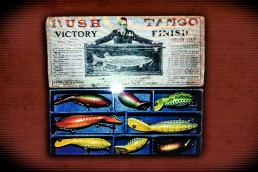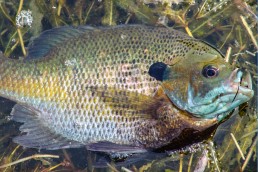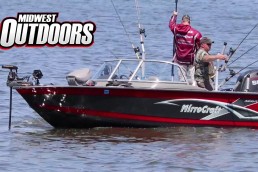Rush Tango
SHARE THIS POST
From the files amassed by early collector Richard Walton, who began accumulating lures, catalogs, patents and information regarding lures in 1909, we found six pages of information about Rush Tango lures.
On their letterhead in 1952 from a letter by A.J. McClane, the fishing editor of Field & Stream, and another from Ray Bergman, Outdoor Life editor, in 1953, it demonstrates the extent of Walton’s search for information.
Bergman shared its patent date, December 22, 1914, but disclosed he’d been fishing with them several years prior. He also recalled the patent lawsuit involving Rush and Heddon.
Design Patent 46,794 was issued December 22, 1914 to LeRoy Yakley and was assigned to Joseph K. Rush, both of Syracuse. Rush sold his lures in several different boxes over the years and also owned the Rush Eraser Company.
Walton recalled a sensational display that caused considerable comment when Rush Tangos were introduced around 1912. He had never seen a scrambled finish on a lure before. He also wrote that one magazine article said the Tango was offered “as early as the turn of the century,” while another claimed it was 1910 and yet another claimed it was made and offered in Indiana.
Walton wrote that he bought one in 1914 at J.A. Rickard Sporting Goods Company store and that Heddon’s Number 6000 Tadpolly was “sure a copy.” The Tadpolly received the patent number of 59,436 on October 18, 1921.
Are you enjoying this post?
You can be among the first to get the latest info on where to go, what to use and how to use it!
In a lawsuit, Heddon claimed that Filmore M. Smith, also of Syracuse, had invented the first floating diving lure and had assigned his patents issued in 1913 and 1914 to Henry S. Welles and that Heddon had acquired the rights from him.
Heddon ended up winning the lawsuit.
Sometime in the 1920s or early 1930s, the rights to make the Rush Tango Minnow was acquired by Horrocks-Ibbotson of New York, the Pradco Company of that era, who swallowed up many lure makers. They made the lures cheaper, without primer and simple, screw-eyes hardware.
Bass Anglers Sportsman Society (B.A.S.S.) offered a “limited edition” version in 2000, reproducing it as an incentive to join. And there now seems to be quite a few of these reproductions available.
Dan Basore is a fishing historian and steward of the history of the sport. In his efforts to preserve fishing history, Basore is always on the lookout for information about early lure makers, old lures, pre- level wind reels, manufacturer catalogs, tournament casting items and the like. If you possess information or materials that can help, please contact Dan Basore, Historical Fishing Display, at 630-393-3474 or 800-347-4525.
MWO
SHARE THIS POST
Did you enjoy this post?
You can be among the first to get the latest info on where to go, what to use and how to use it!
Dan Basore
Dan Basore is a fishing historian and steward of the history of the sport. In his efforts to preserve fishing history, he is always on the lookout for information about early lure makers, old lures, pre-level wind reels, manufacturer catalogs, tournament casting items and the like. If you possess information or materials of this kind, please contact him at 630-393-3474 or by email at ollures@aol.com.



